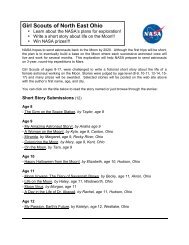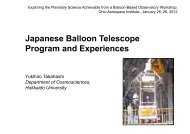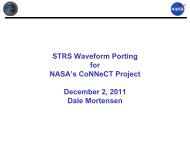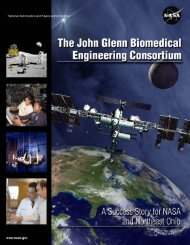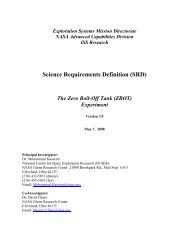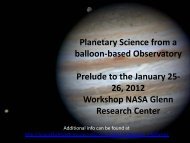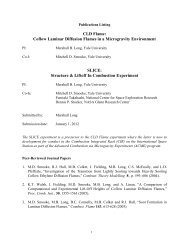Amusement Park Physics With a NASA Twist - Space Flight Systems ...
Amusement Park Physics With a NASA Twist - Space Flight Systems ...
Amusement Park Physics With a NASA Twist - Space Flight Systems ...
Create successful ePaper yourself
Turn your PDF publications into a flip-book with our unique Google optimized e-Paper software.
path much of the time. The free-fall ride makes a vertical, or<br />
up-and-down, type of linear motion. Roller coasters use a<br />
combination of horizontal and vertical linear motion, as well<br />
as curved motion, as the cars charge over hills and careen<br />
around corners. The pendulum ride, though it may not always<br />
travel in a complete circle, moves in a circular path, as does<br />
the ferris wheel. These types of motion contribute to the chills<br />
and thrills of the rides. Knowing these three types of motion<br />
will come in handy when one wants to compare a ride, like<br />
the free fall, to something outside of the amusement park,<br />
such as a drop tower. Both, obviously, have vertical and linear<br />
motion.<br />
Three types of motion that are<br />
found in amusement parks are<br />
1. Linear motion<br />
2. Curved motion<br />
3. Circular motion<br />
The Measure of Motion<br />
There is more to motion than just the path an object takes.<br />
One can determine if one will feel heavier, lighter, or weightless<br />
by studying its motion beforehand. By measuring the<br />
ride’s position at different times, one can find its displacement,<br />
velocity, and acceleration.<br />
The position of a ride is where it is at any given moment.<br />
Imagine a giant ruler that could be held up next to a free-fall<br />
ride to measure the car’s position during the ride. One might<br />
place the zero point of the ruler at ground level and label it as<br />
Y f , for the final height. If the ride is 30 meters tall, then the<br />
position of the car at the start is 30 meters and is labeled Y i ,<br />
for the initial height. This causes the location of the car’s<br />
position at the start to be positive, since it is above the<br />
ground. After 1 second of fall, the car’s position will be 25<br />
meters. After 2 seconds, the position will be 10 meters and<br />
after less than 2.5 seconds the position will be zero with the<br />
rider located at the bottom of the ride.<br />
This drop tower ride is an example of a<br />
ride having linear motion.<br />
Displacement<br />
When a ride changes position, one can calculate the difference<br />
between these two positions. This is called finding the displacement.<br />
When the free-fall ride is over, the displacement of the car<br />
is found by subtracting its starting or initial height from its ending<br />
or final height (Y f – Y i , or 0 meters – 30 meters = –30 meters).<br />
Frames of Reference<br />
In the first example, the giant ruler was used to define a<br />
reference frame in which zero is at the ground level and<br />
upward is positive. However, the lowest point of a ride may<br />
be above the ground level. In a second example, one may<br />
want to move the ruler to change the reference frame, to<br />
The path going down a roller coaster hill<br />
is one example of curved motion.<br />
15<br />
<strong>Amusement</strong> <strong>Park</strong> <strong>Physics</strong> <strong>With</strong> a <strong>NASA</strong> <strong>Twist</strong><br />
EG–2003–03–010–GRC



